This is a Kodak Monitor Six-20 folding camera made in the USA by the Eastman-Kodak company. This was one of the last medium format folding cameras made by Kodak, and is loaded with features including a 9-speed shutter and well built lens. It is the spiritual successor to the Kodak No.1 Autographic Special from 1916 also reviewed on this site. This model features the top of the line Anastigmat Special 4 element Tessar style lens which was Kodak’s best lens, second only to the 5 element Ektar. The camera has advanced features such as an automatic frame counter, double exposure prevention, an uncoupled depth of field scale, and dual viewfinders. It was extremely well made, and today, 75 years after it was made, is still capable of excellent photography.
Film Type: 620 Roll Film (8 6cm x 9cm exposures per roll)
Lens: 101mm f/4.5 uncoated Kodak Anastigmat Special 4 elements
Focus: 3.5′ to Infinity
Type: Scale Focus Flip Up Viewfinder and dual Brilliant Reflex Viewfinder
Shutter: Kodak No.1 Supermatic
Speeds: B, 1 – 1/400 seconds
Exposure Meter: None
Battery: None
Flash Mount: None
Manual: http://www.cameramanuals.org/kodak_pdf/kodak_monitor_six-20.pdf and http://www.cameramanuals.org/kodak_pdf/kodak_monitors.pdf
History
Kodak released their first reloadable film camera, simply called the “Kodak” in 1888. It had a roll of film inside that could shoot 100 exposures, but when you were done with the roll, you sent the entire camera back to Kodak and they would develop your film, reload the camera, and return it to you. Over the course of the next 30 or so years, Kodak had created a huge number of other film sizes and formats. By 1920, Kodak had well over 30 different film sizes that they were making. Some films were so uncommon that they were designed for only one model of camera.
As snapshot photography became more standardized, the huge variety of film formats was starting to dwindle and a couple of the more popular formats became popular choices. The most popular was 120 film which was first introduced in 1901 for the Kodak Brownie No. 2 camera. The film was 61 mm wide and supported a large variety of exposure sizes with a width of 6 cm.
For whatever reason, 120 film caught on more than other formats and by the 1920s, many American, German, and even Japanese cameras were being designed to use 120 film. Unfortunately for Kodak, they didn’t have a patent on the size or design of the film, so other companies were able to make their own version of 120 film. One of the most common competitors was AGFA’s B2 film which is nearly identical to Kodak’s 120 film. Any camera designed for B2 film can use 120 without any issues.
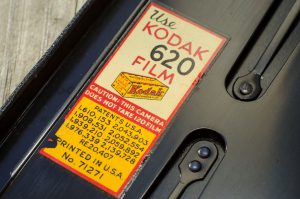
It was this inability to prevent Kodak’s competitors from making the same film that in 1931 prompted Kodak to design a whole new format which they would refer to as 620 film. The 620 format would use film that was physically the same size and length as 120 format, but the spools would be thinner and have a shorter length than 120. 620 would also have all metal spools as opposed to the wood and metal spools of 120 format. The ‘6’ in the name 620 was decided upon because initially, you would get six 6×9 exposures per roll, but by the time the film hit the market, this was changed to eight 6×9 exposures, so the ‘6’ in ‘620’ ended up being meaningless.
Kodak would also do the same thing with 116 film which was another very popular film format at the time, and would release their own version, called 616.
 Kodak believed that they had a large enough influence on the photographic market that by introducing it’s new 620 format, the world would follow. After the release of 620 film, Kodak would stop producing it’s own cameras that would use 120 film. Since 620 has spools that are smaller than 120 spools, you could not simply put a roll of 120 film into a camera designed for 620.
Kodak believed that they had a large enough influence on the photographic market that by introducing it’s new 620 format, the world would follow. After the release of 620 film, Kodak would stop producing it’s own cameras that would use 120 film. Since 620 has spools that are smaller than 120 spools, you could not simply put a roll of 120 film into a camera designed for 620.
During the 1930s, Kodak released a large variety of 620 film cameras, and since they wanted the world to know that these were designed for Kodak’s new film, the number 620 or more commonly, ‘Six-20’ was often featured in the model name of the camera. Kodak would make models like the Brownie Six-20, Jiffy Kodak Six-20, Vigilant Six-20, and the Monitor Six-20.
In the years that followed Kodak’s release of 620 and 616 film, some American companies like Argus and Imperial would take Kodak’s lead and start releasing 620 exclusive models. Other companies like Universal and a few early Argus models could support both 120 and 620 at the same time. The problem was, pretty much every other company, including other American companies like Ciro and Graflex, and all German and Japanese companies stuck with 120 film.

Kodak would continue to push 620 film on new cameras well into the 1950s, but by the 1960s, they had pulled out of the camera making business altogether and would concentrate on film exclusively. Kodak would continue to produce 620 film until officially discontinuing it in 1995, leaving 120 as the only medium format film still widely available.
Today, if someone wants to use a camera designed for 620 film, you have to get empty 620 spools and take 120 film and roll it off the 120 spool and “respool” onto a 620 spool. Some people have attempted to modify 120 spools to fit into 620 cameras, but I do not like this method because it involves physically shaving or cutting the plastic 120 spool which can damage or expose the film, or in some cases, even damage the camera. I talk about my thoughts on this quite a bit in my review for the Kodak Medalist which was my first 620 camera, so you can head over there to read all of my thoughts on it, but for a quick reference, check out this video on Youtube that shows my preferred method for respooling 120 film onto a 620 spool.
The Kodak Monitor Six-20 was made between 1939 and 1948, making it one of Kodak’s last medium format folding cameras before they concentrated exclusively on smaller 35mm and 828 cameras. There was also a Kodak Monitor Six-16 which was essentially identical, except it used 616 film.
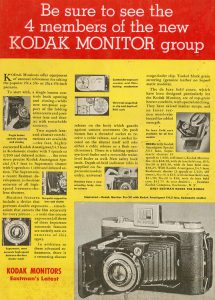
The Kodak Monitor was a pretty high end folding camera that had advanced features for it’s day like a frame counter, double exposure prevention, self-timer, an excellent lens and shutter, and a depth of field calculator. According to the image to the right, in 1940, the Monitor Six-20 with the Anastigmat Special lens and 9-speed Supermatic shutter sold with a field case for $48.25, and the Monitor Six-16 was $55.00 which when adjusted for inflation, is $816.51 and $930.74 today.
Both Kodak Monitors were based on the Kodak Vigilant Six-16 and Six-20 which was a simpler version of the camera with a very basic top plate and without the frame counter, double exposure protection, or depth of view dial. Some people actually prefer the Vigilant cameras to the Monitors because they share the same lenses and shutters, but without all of the extra bells and whistles.
Today, there aren’t a lot of people in the market for a Kodak folding camera from the 1940s that uses 620 film, but when paired with the 4-element Anastigmat Special like the one in my collection, it can interest a few select people. This is definitely one of those models that flies under the radar with collectors because most people simply do not talk about it often. This is a shame because if you are willing to take the time to get some film on a 620 spool, this camera is capable of some excellent shots.
Repairs
This Monitor arrived in really nice condition. The body was in great shape, the leather was not peeling, the glass was clean, and the shutter appeared to fire at all speeds accurately. Other than a gentle wipe down, the camera would have been ready to start shooting, mostly.
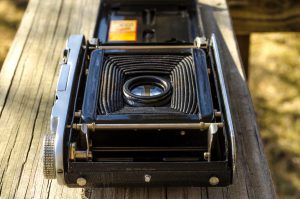
The one glaring issue is one that plagues a large majority of folding cameras from the 1930s through the 50s, especially ones made by Kodak. That issue is holes in the bellows. The Germans and to some degree the Japanese, were all good about using higher quality leather or leather like bellows that if taken care of, would stand the test of time and not develop holes. Kodak and many other American manufacturers started using cheaper, synthetic material around this time which hasn’t held up so well.
To be fair, I don’t think Kodak ever considered that anyone would want to use these cameras more than half a century later. The material they chose served it’s purpose through the “normal” life of the camera. For collectors such as myself who want to still try to use these cameras, the light leaks need to be addressed.
There are many ways you can attempt to repair bellows, most of which involve using some type of black substances to cover up the holes. A quick search on Google will give you a bunch of results in how people have done this. Sadly, no attempt at repairing bellows is permanent. If the bellows has already started to crack or disintegrate, it will continue to do so. The only real solution is to completely replace the bellows. Thankfully, there are still shops who will make a set of bellows for pretty much any camera. The downside to this, is that it’s not cheap, and replacing bellows can be a difficult job and not one I really want to tackle.
I was willing to accept a temporary repair to the bellows on this camera so I can shoot a couple of rolls in it. No matter how nice this camera is, it’s not one I will use often, so I think I could get away with a repair.

If you want to detect light leaks in bellows, the simplest way is to open the camera with the bellows fully extended in a completely dark room. Open the back of the camera and look into the bellows through the film compartment and use a bright flashlight and shine it from the front of the camera all over the bellows. Any pinhole of light you see needs to be repaired. Sadly mine had hundreds of them. Pretty much every single corner of every single pleat had a number of them. You could clearly see how the material was disintegrating. If you only saw a couple of pinholes, you can attempt to repair them individually, but mine had literally hundreds of them all over the bellows and addressing them individually was not a realistic option. A more drastic repair would need to be made.
The picture to the left partially shows some of the light leaks I had with this camera. It was really hard to get this shot, so it doesn’t really do a good job of showing how bad it was on this camera. All 4 corners of the bellows had these leaks in every single pleat. As a side note, the inside of these bellows was pretty dirty. There are small white specks of gunk that I blew out with compressed air.
There are several products that you can buy which will help seal out light. Some people recommend using black fabric paint which is available at most fabric stores. I’ve heard of some people using some type of homemade recipe using school glue and black dye, but the method I chose to go with was liquid electrical tape. In my mind, the flexible nature of electrical tape and its ease of application won me over. Most big box hardware stores like Menards or Home Depot should sell this. I bought a bottle from my local Home Depot for about $5. It comes in a variety of colors, but all you need is black.
It really doesn’t matter whether you apply the sealant to the inside or the outside of the bellows, but if you do it on the inside, you can retain a stock appearance to the camera. The potential downside to doing it on the inside however, is that for one, its more difficult, but two, if it ever fails and flakes off, it can get on the inside lens or your film.

Knowing that my bellows was in such bad shape, I decided to just apply a thin coating on all of the corners of the camera. I put on a pair of latex gloves (like the kind you can *ahem* borrow from a hospital) and I used my finger to smear the liquid electrical tape all over the inside of the bellows. While you want to make sure you get enough in there to evenly coat all of the corners, you want to make sure you don’t put it on too thick, otherwise it could interfere with the bellows ability to fold. And of course, you want to avoid getting any on the inner lens element.
Liquid electrical tape takes at least 24 hours to dry and cure, so once you are satisfied you have it evenly coated all over the inside of your bellows, do NOT fold it shut. Leave the camera open, and put it somewhere in a well ventilated area and leave it open until you are sure its 100% dry.
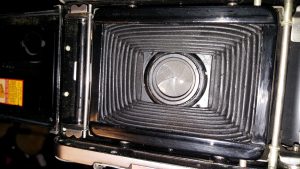
Once everything is dry, you will want to close and open the camera several times to make sure that the bellows can still fold properly, and to make sure its not flaking off inside of the camera. The very first time I closed it, it was very stiff. You could hear the bellows creaking as it closed, but I was able to do it. I worked the camera open and closed several times and it got a bit easier after a couple of times. After I was sure it was OK and not flaking off, I took the camera into a dark room and got out my flashlight to see if there were any new light leaks and thankfully there were not. The bellows is light tight for now. I’ll shoot a couple of rolls of film in it, and then just remember to recheck for holes each and every time I take this camera out to shoot. See the picture to the right of what the bellows looks like closed after the liquid electrical tape has dried.
My Thoughts
My first vintage camera was a Kodak folder, and although I really enjoyed that first experience, I never really thought Kodak folders would be a “thing” for me. While I wouldn’t say I have a dedication to Kodak folders now, I do have more respect for them, especially the higher end models like the Kodak Monitor Six-20 and the No.1 Kodak Autographic Special which I reviewed earlier in 2015.
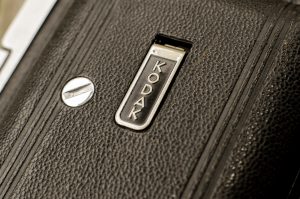
It is very sad to me that Kodak disappeared from the medium to high end camera market. Sure, their film was the foundation of photography in the 20th and 21st centuries, but there was a time when Kodak knew how to make good cameras. The Kodak Monitor Six-20 was one of the last folding models to shoot medium format film and it ended an era with some pretty great specs. If a folding camera could ever be described as a tank, this is it. I mentioned earlier that this is the Kodak Medalist of folding cameras, and I still believe that. There are some design elements and features that really remind me of the Medalist, it even shares the same 9-speed Supermatic shutter. Even though the lens is not labeled as an Ektar, it is very close in optical performance.
My “repair” of the bellows is really just a Band-aid and I know that at some point in the future, the light leaks will become an issue again, but even if I never shoot this camera again, it really displays quite nice. Older roll film folders display nicely in portrait orientation, but like the smaller 35mm folding cameras of the 30s and 40s, this one displays nicely in landscape orientation. The prominent MONITOR logo on the flip up viewfinder is large and elegant. The supple leather covering has nice pinstriping that adds a touch of class to what could have otherwise been bland pebbled fake leather. Even the knurled winding knob on top of the camera is solid metal and just looks classy. This camera is a transition model from that time when design was purposeful, but still beautiful at the same time.
If you are in the market for a Kodak Monitor, I highly recommend looking for one with the Anastigmat Special lens. Not only do you get the better lens, but you get the better Supermatic shutter as well. In addition to the better shutter, you also get the depth of field dial on the top plate. This dial is rather useless, but it looks nice. I’ve read other articles that knock this camera for it’s complexity, and one reviewer even went as far as to say the Kodak Vigilant Six-20 camera with the same lens and shutter is the better camera because it is a simpler camera with less to break. I guess that could be true if all you cared about was simplicity with a great lens, but in my opinion the Kodak Monitor with the Anastigmat Special is the complete package. Its a very capable camera with advanced features, a really great look, and an even better lens.

The viewfinder on this camera is a standard two piece flip up viewfinder similar to the one on the Kodak 35 which I raved about in my review. Considering how small and dark many other scale focus cameras are from this era, I find the flip up viewfinders to be extremely bright and easy to use, especially with prescription glasses.
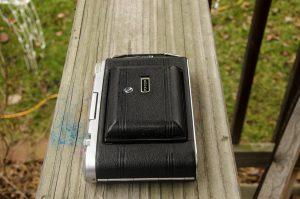
It should come as no surprise that the Monitor is not a point and shoot camera. This is a camera that requires a bit more attention than the typical camera. As it is a folding camera, you need to decide if you want to keep folding it shut, or just leave it open in between shots. This was especially true since my “repair” job with the liquid electrical tape has made the bellows quite stiff. You can hear it creaking and groaning each time you open it, so I wanted to put as little stress on it as possible. I did have the foresight before loading film into the camera to re-check the state of the bellows with a flashlight, and I was pleased to see that there are no new light leaks in my repair job.
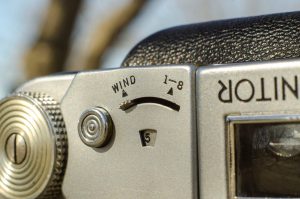
A note about loading film into the Monitor is that this camera does have an automatic frame counter with double exposure prevention. This is achieved by the switch marked “WIND” and “1-8”. My understanding is that this works similarly to the film transport on the Kodak Medalist, but for whatever reason, it is far less reliable on the Monitor. While there isn’t a lot of info on the Internet about this camera, the few articles that I’ve read by people who have shot one, all seem to recommend to not try and use the built in frame counter. Instead, you should use the red window on the film door to advance your film. Like any medium format camera with a red window, it is important to not open the window in bright sunlight as modern film is a lot more sensitive than the films that were available when this camera was new.
My Results
It took me a while to find the time to take out the Monitor, but the first Saturday in February was in the upper 40s and sunny, so I loaded up a few cameras and went downtown Chicago to shoot some film. I thought the medium format 6×9 format would lend itself to some nice city skyline shots.
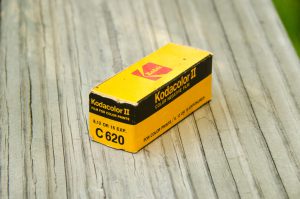
I loaded in a roll of 620 Kodacolor II film which had expired in the 80s. I used a very similar film in my Kodak Medalist back in October and got some wonderful shots from that roll, so I had hoped to see similar results. Shooting with film that is 3 decades expired means that I should shoot with the camera 3 stops over exposed. Since it was a bright and sunny day, I figured I’d have no problem with this if I followed the Sunny 16 rule and added 3 stops. Since I wasn’t shooting on a tripod, I didn’t want to slow down the shutter too much, so I used a combination of 2 stops larger aperture and one stop slower shutter. Kodacolor II is ISO 100 so that means most of my shots were done at 1/50 and f/8 in bright sunlight. I did take a couple of shots in the city in shade, and for that, I went with 1/10 and f/5.6 and stabilized the camera on the roof of my car. If you’re wondering why I didn’t open the lens all the way to f/3.5, I wanted to try and retain as much of the sharpness as possible, and keep the lens close to the “sweet spot” that is typical of lens sharpness between f/5.6 and f/11.
Other than the size, using the Kodak Monitor is quite pleasant. Although big, it still handles well. The shutter release is nicely positioned where you want it to be, and the shutter speed and aperture levers are large and easy to reach. While I still found it necessary to look at the front of the camera to change them, their position would be relatively easy to locate (especially the shutter speed) if you had to change it on the fly.
I walked around Chicago and took a couple of skyline shots and ones that I thought would most benefit the large size and aspect ratio of the 6×9 medium format frame, and things seemed to be smooth sailing through the first couple of exposures, but I noticed that around the 4th exposure, advancing the film to the next frame was becoming difficult. By the 5th frame, it was very hard to turn the film advance. I was able to barely get it to the 6th exposure at which time I stopped trying to advance the film. Something was clearly wrong. I toggled the switch on the top plate between WIND and 1-9 several times, but that didn’t seem to help. Upon doing some research online I read some theories about one of the film spools being slightly bent, but then I saw an article claiming that the film loading procedure is very specific in this camera. I don’t remember struggling when loading the film in the first place, and the first 3 exposures advanced easily, so what could I have done wrong?
Not wanting to risk causing further damage to the camera, or tearing the film, I decided to just open the camera in a dark bag, and just lose the last two exposures. I’ll get 6 shots out of this roll instead of 8. I discovered that the likely cause of the jam was that the supply spool was not staying in position. I could clearly feel it “lifting” out of position. When I would push it back down, the film could be easily wound, but as soon as you began to wind the film again, it would lift out of position. This seems to get worse as you get further into the film, because less of it is on the supply side. At whichever time I shoot with this camera again, I will have to see if there is any adjustment I can make to prevent this from happening again.
Looking at the results, we’ll get the most obvious thing out of the way. Yes, the light leaks are still there. I knew my repair was merely a Band-aid, but I am somewhat bummed that I couldn’t even get through the first roll, but alas, this is what I got. Of the 6 shots, there were two others that were much worse, so I am only showing these 4, but of what you can see, I was really impressed.
The large Anastigmat Special lens really delivered on what I had hoped it would. Detail galore, nice contrast and color (especially considering this is 30 year old expired film), and very little vignetting. It would be interesting to do an A/B comparo between this lens and the 5-element Ektar in the Medalist.
I mention earlier that the Monitor is not a small camera, but compared to other medium format 6×9 options, it really is quite easy to shoot. I really love these Kodak flip up viewfinders. The one on the Kodak 35 is just as bright and easy to use as the one here. Interestingly, the Monitor also has a brilliant waist level finder on top of the shutter like an older folding camera, but I did not use that.
I absolutely enjoyed using this camera and was extremely bummed that I was unable to repair the light leaks, but there is enough here to where I think it is worth it to get it professionally repaired. I don’t think replacing bellows is something I want to attempt, so I’ll have to find someone to do it for me. I know it won’t be cheap, but for this camera, I really think it’s worth it.
I fully expect to not find as many people who adore this camera as much as I do, but that’s OK. This is one of those rare examples of a camera that is as good as anything else out there, yet it still manages to fly under the radar.
My Final WordHow these ratings work |
The Kodak Monitor was one of the last medium format folding cameras Kodak would make, yet it had many state of the art features for the time. It is a handsome camera with one of the best lenses Kodak has ever made. There are two options for the viewfinder, one of which is a very bright and easy to use flip up finder on the top plate. The camera has features like an auto-stop frame counter, double exposure protection, and even a depth of field scale. For it’s size, its easily portable, and the results it delivers are excellent. Sadly, it was saddled with a composite paper bellows that almost never is without holes or tears and my first attempt to repair it failed. If you can find a Monitor with good bellows, or are willing to place yours, you have one of the most portable and capable 6×9 medium format cameras ever made, with a lens that rivals anything made today. | ||||||
| Images | Handling | Features | Viewfinder | Feel & Beauty | History | Age | |
| 2 | 1 | 2 | 2 | 2 | 1 | 40% | |
| Bonus | None | ||||||
| Final Score | 14.0 | ||||||
Additional Resources
http://camerapedia.wikia.com/wiki/Kodak_Monitor
http://camera-wiki.org/wiki/Kodak_Monitor
https://blog.jimgrey.net/2012/08/27/kodak-monitor-six-20/
http://www.bnphoto.org/bnphoto/KodakMonitor.htm
https://mikeeckman.com/photovintage/vintagecameras/monitor/index.html

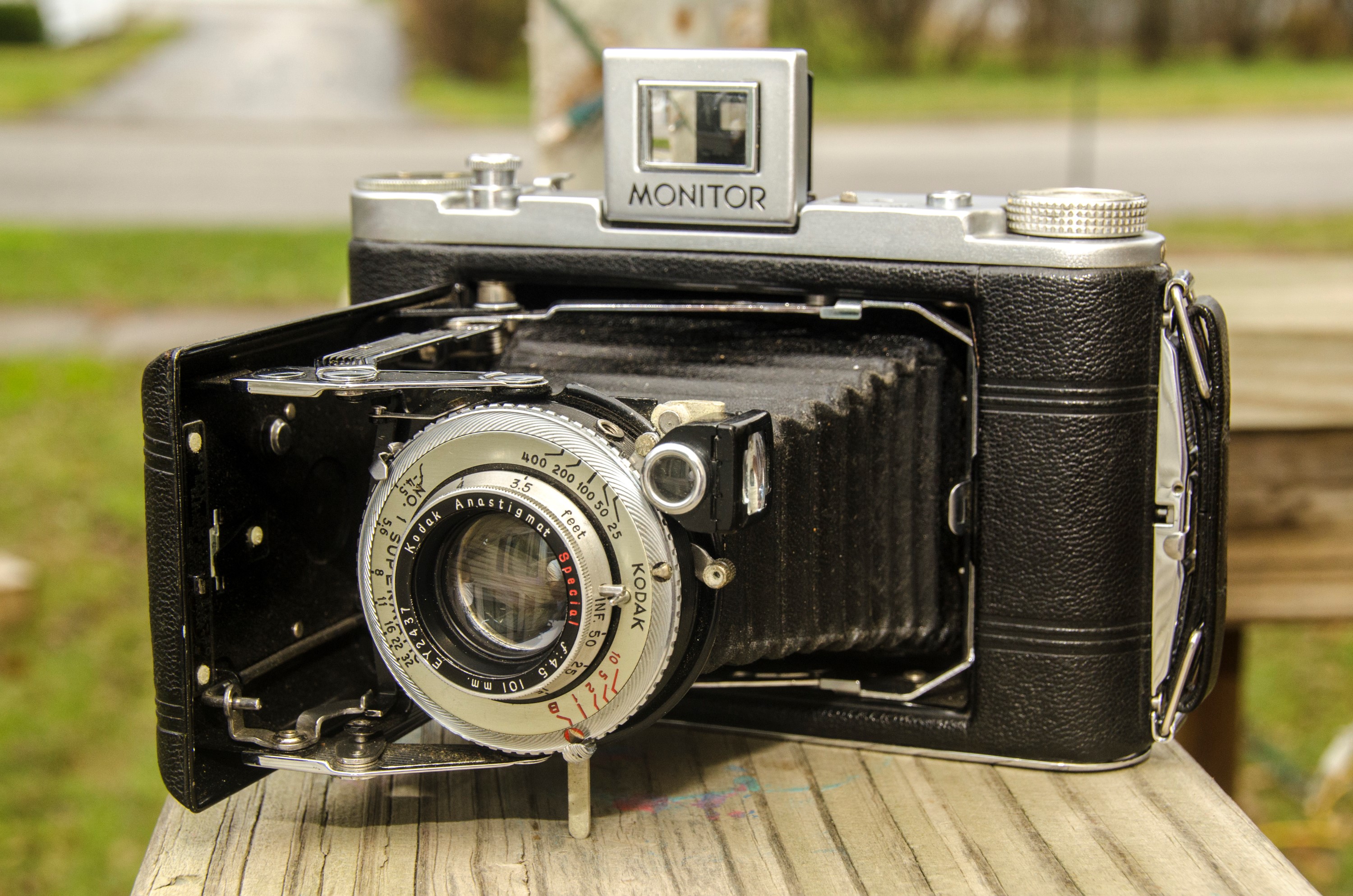
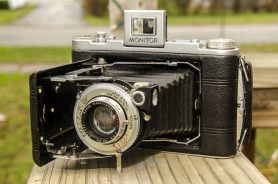
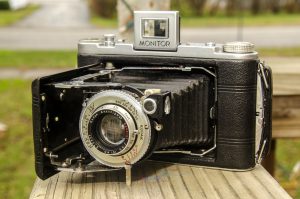




Great article. I have a Kodak Monitor with light leaks too. Where are these shops that have replacement bellows? Please recommend.
I looked into this once before and I don’t think there is anyone out there that has premade bellows in stock, that would fit the Monitor. Any type of replacement would need to involve a custom made set of bellows. You’d need to call around and find places that do custom bellows, which can get expensive.
I enjoyed reading your entire article on this camera. I only started reading the article because I knew I had one stored away in my hall closet not being touched for the 35 years I have lived here in Addison,IL. The one I have is identical to the one you own only in perfect condition. There hasn’t been a roll of film in it since my uncle gave it to me when I was 10 years old and my mom put it away for me. I’m now 70. Would you be untested in purchasing this perfectly pristine (bellows like factory new) camera for your collection? I can send you pictures if you send me your e-mail There’s not even dust on this camera. The case is still on it. One of the straps is broke. I don’t know how that could have possibly happened. But it’s all there! Thanks for your time. It is the Anastigmat.
I recently acquired my late father’s Monitor camera. I have lots of photos he took in Bogota Columbia, as a young man working there for Standard Oil in the 1940’s. I carefully opened the folding bellows but now I can’t get it closed. I don’t want to force it and break the mechanism. Can you give me a hint as to how to close up the camera? Thank you!
Barbara, with the lens facing you and the door facing the floor, use both thumbs and press in on the small rectangular tab near the top of the hinge, near the upper corners of the bellows. Once you press that in, you should feel the door lock release, and then you can easily fold the camera shut again.
Yet another camera my late father had in his youth. He passed away 10 years ago so suddenly I had 7 or 8 of his old Kodaks, an old bellow-type Polaroid and even a Minolta X700. I gave the X700 to my brother in law and ditched the rest of the lot so someone else could possibly use them. The 620 seemed to work, the bellows opened and closed without binding and the shutter fired at all speed settings. I don’t know if they were accurate or if the bellows had light leaks but with no available film to experiment with, it seemed like a white elephant, so off it went along with the others.
Does anyone have any idea what one of these would go for today in very good condition.
Hi Susan, I don’t do appraisals, but if you want to learn more about what your camera is worth, I would definitely recommend checking out this article.
https://mikeeckman.com/2020/02/what-is-my-camera-worth/
Hey Mike… first of all, thanks so much for your website. It’s amazing resource, and when I think about all the man hours it must entail, I’m amazed you found the time to have children.
I’ve recently been listening to your equally amazing, entertaining and inspiring podcast, and heard mention of the Monitor. This camera has been an itch I’ve been wanting to scratch for years now, but have been unwilling to deal with the bellows problem. I’m curious to know if — in the years since this post — you’ve heard of anyone who’s capable of replacing those bellows. My Googling has been fruitless, and I’m incapable of any manual labor myself.
Thanks again for all you do,
Cheers,
James
Hi James, glad you like the page and the podcast! We’re always looking for guests to come and ask us questions, so keep an eye out for the episode announcements, and if you have time, feel free to jump in sometime.
Sadly, the situation with the Kodak Monitor has not changed. In fact, another of the Camerosity hosts, Anthony Rue is also a huge fan of the Monitor and has asked the same question. Jurgen Kreckel from certo6 makes and installs custom bellows for many folding German cameras, and he refuses to even touch the Monitor. Apparently Kodak riveted those things to the camera in a way that is very difficult to replace. It can be done, but the cost and effort seems to be higher than most people want to consider.
I am still waiting to find someone who will do it though, so if you ever do get yours done, PLEASE let me know as I’d love to shoot this camera again.
Thanks, Mike. I was actually going to contact Jurgen (I’ve picked up a Bessa RF and an Agfa Record III from him in the past, and been impressed with his work). In the meantime, I’ll let you know if I find anyone.
BTW, I know you’re tremendously backlogged on cameras to review, but if you ever want a crack at a Welta Perfekta (6×6) or Superfekta (6×9), lemme know. I’m a bit of a TLR freak, and while a compact folding TLR did sound appealing, and the lenses do yield great results, they are hands-down the most awkward, infuriating cameras I’ve ever shot with. So if I have to part with one for a while, not a problem. (insert frustrated emoji here)
Cheers,
James
Thank you for this post. I just came home from work to my Monitor waiting in a box. I am so thrilled to find it is in like-new condition, no light leaks upon a quick inspection. Even the leather case and strap are in excellent condition. I won it in an auction for $43. I’m currently shooting a Kodak Medalist I I had serviced with 620 film, and I guess this will be the next to try. I don’t know what kind of magic amber this was stored in, but it’s a real beauty! Now time to try the shutter etc. … we’ll see.